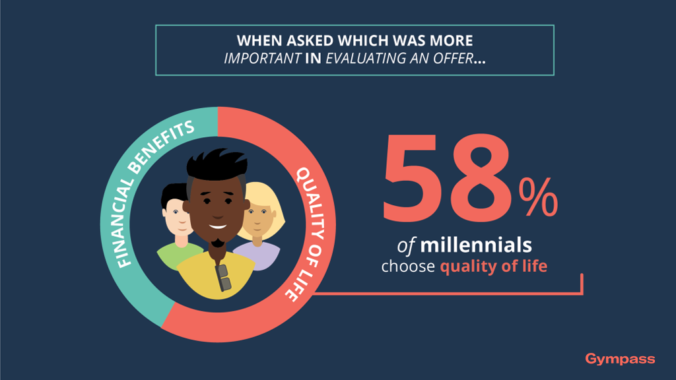Recruiting and retaining millennials in an employees’ market: Success of wellness strategies
- 4 Min Read
As job opportunities become more abundant and unemployment rates decrease, finding and retaining top-notch talent can be a challenge. This is a candidate’s market in which competitive salaries are often no longer enough, especially to millennials, who are always on the lookout for new opportunities. Gympass goes on to discuss attracting and retaining this generation in today’s age.
- Author: Gympass
- Date published: Jan 24, 2019
- Categories


To entice and engage top performers in a tight labor market, HR professionals are being tasked to think outside the box and identify key supplemental offerings that not only enhance overall compensation packages, but also improve employee experience.
According to Catalyst.org the global talent shortage is at its highest in over 10 years.1 In the US, the unemployment rate has fallen beneath 4%, weekly jobless claims are at a 49-year low, and wages are growing at their fastest pace since 2009.2,3 This is great news, but it makes HR professionals’ jobs more difficult. When positions are as plentiful as they are today, top performers have many options, and companies must consistently improve their employee offerings to remain competitive. Sixty-six percent of workers agree that a strong benefits and perks package is the determining factor when considering a job offer and 61% would be willing to accept a lower salary if a company offered a great package.4 Conversely, inadequate benefits motivate 42% of employees to consider leaving their jobs and 55% have already left jobs because they found better benefit offerings elsewhere.5
What’s interesting—and promising—is that the employees most likely to quit are also the most sensitive to wellness offerings. Millennials make up the largest and fastest growing segment of the labor force.6 While well-being programs are important to all age groups, millennials are particularly interested in them. In fact, 43% of millennials cite their company’s wellness programs as a reason they stay at their jobs, compared to 35% of Gen Xers and 28% of Boomers.7
According to a 2016 Fidelity study, when asked how much of a pay cut they would be willing to take for an improved “quality of work life” millennials report, on average, a $7,600 pay cut annually.
When asked which is more important when evaluating an offer– financial benefits or improved quality of work life– 58% choose the latter.8#

For millennials in particular, wellness programs need to be comprehensive, involving physical, mental, and social well-being. Such programs make more than half of millennials (52%) “feel better about their company”, compared to 34% of Boomers.7 The younger generation is likely to expect even more from corporations: according to Deloitte, “Gen Z professionals may not perceive these programs as a ‘perk’ or a ‘gift,’ but rather as an expectation.”9
Benefits that support employees’ physical, mental, social, and financial well-being are valued by top talent of all ages, and play a key role in employment related decision making. Such programs are of vital importance for talent acquisition and retention strategies alike.
Investing in employee wellness benefits is a savvy, some would say necessary move. Especially if your goal is to recruit millennials, who are the largest (and growing) segment of the labor force. Now more than ever, wellness incentives can both attract and retain top talent, and create happier and healthier lives for all employees.
Download our latest white paper to learn more about how wellness offerings are increasingly vital to talent strategy.
Generations defined:
Millennials: born 1981‐1997
Generation X: born 1965‐1980
Boomers: born 1946 to 196410
References:
- Turnover and retention. Catalyst. https://www.catalyst.org/knowledge/turnover-and-retention. Published May 23, 2018. Accessed September 18, 2018.
- Mutikani L. U.S. weekly jobless claims drop to near 49-year low. Reuters. September 13, 2018. https://in.reuters.com/article/usa-jobless/u-s-jobless-claims-fall-to-near-49-year-low-idINKCN1LM1RH?feedType=RSS&feedName=businessNews. Accessed September 18, 2018.
- Kitroeff N. Unemployment rate hits 3.9%, a rare low, as job market becomes more competitive. New York Times. May 4, 2018. https://www.nytimes.com/2018/05/04/business/economy/jobs-report.html. Accessed September 18, 2019.
- The benefits of benefits: why employers can’t afford inadequate workplace perks. Randstad US. https://www.randstadusa.com/about/news/the-benefits-of-benefits-why-employers-cant-afford-inadequate-workplace-perks/. Accessed September 18, 2018.
- Bolden-Barrett V. Over half of US workers have left jobs after finding better benefits offerings. HR Dive. https://www.hrdive.com/news/over-half-of-us-workers-have-left-jobs-after-finding-better-benefits-offeri/525877/. Published June 19, 2018. Accessed September 18, 2018.
- Fry R. Millennials are the largest generation in the U.S. labor force. PEW Research Center. http://www.pewresearch.org/fact-tank/2018/04/11/millennials-largest-generation-us-labor-force/. Published April 11, 2018. Accessed September 18, 2018.
- Consumer Health MindsetTM study 2016. AON. http://www.aon.com/attachments/human-capital-consulting/2016-Consumer-Health-Mindset.pdf. Accessed September 18, 2018.
- Better quality of work life is worth a $7,600 pay cut for millennials. Fidelity Investments. https://www.fidelity.com/about-fidelity/individual-investing/better-quality-of-work-life-is-worth-pay-cut-for-millennials. Published April 7, 2016. Accessed September 18, 2018.
- O’Boyle C, Atack J, Monahan K. Generation Z enters the workforce. Deloitte Insights. https://www2.deloitte.com/insights/us/en/focus/technology-and-the-future-of-work/generation-z-enters-workforce.html. Published September 19, 2017. Accessed September 18, 2018.
- Pew Reasearch Center. The generations defined. http://www.pewresearch.org/fact-tank/2018/04/11/millennials-largest-generation-us-labor-force/ft_15-05-11_millennialsdefined/. Published May 8, 2015. Accessed September 28, 2018.
Find more about Gympass here.


